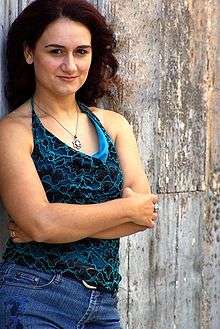Women in Malta
 Simone De Battista, Maltese film and theatre actress | |
| Gender Inequality Index[1] | |
|---|---|
| Value | 0.220 (2013) |
| Rank | 41st out of 152 |
| Maternal mortality (per 100,000) | 8 (2010) |
| Women in parliament | 14.3% (2013) |
| Females over 25 with secondary education | 68.6% (2012) |
| Women in labour force | 49.3% (employment rate Eurostat definition, 2014)[2] |
| Global Gender Gap Index[3] | |
| Value | 0.6761 (2013) |
| Rank | 84th out of 144 |
Women in Malta refers to, amongst others, the social status of women in the Maltese society in different context of Maltese history, past and present.
Education
Catholic schooling has indicated a large impact in the changing role of women for countries such as Malta and Japan. Catholic schooling of girls in Malta, for example indicates: “...evidence of remarkable commitment to the full development of girls in a global society.”[4]
Politics and suffrage
Fifteen general elections have been contested since the granting of universal suffrage in Malta in 1947. Only 73 women have contested in these elections. The number of men, on the other hand, has exceeded 1000. The number of women contesting general elections has, however, increased over the years. In fact, the 1998 elections saw 24 women candidates participating, the highest number to date, with six of these getting elected, registering a 25 percent success rate.
The smallest number of female candidates was in 1947, these numbering only two. However, the result showed a 50 percent success rate, since Agatha Barbara was elected. The election of 1955 saw the lowest percentage of women candidates being elected with a 14.3 percent success rate, when only one candidate out of seven was elected. After this discouraging result, the success rate rose slowly until, in the 1976 election, there was a 42.3 percent success rate for women candidates. At that time, three out of seven contestants were returned. These were two Labour candidates Agatha Barbara and Evelyn Bonaci, while Anne Agius Ferrante from the PN obtained a seat following a by-election.
However, the success rates of the first and third elections won by female candidates have never been matched up till now (in 1947 it reached 50 percent while in 1951 it was 57.1 percent). The rate slowly rose to 42.9 percent in 1976, but this momentum was lost and success fell to 20 percent in 1981. It rose to just 28.6 percent in 2003. The 2003 election gave the same results as that of 1998, with six women parliamentarians, three each for the two main political parties.
Abduction and marriage laws
In 2015, Malta was criticized by Equality Now, for a law, which, in certain circumstances, can extinguish the punishment for a man who abducts a woman, if following the abduction, the man and woman get married.[5] (Article 199 and Article 200 of the Criminal Code of Malta[6])
See also
References
- ↑ "Table 4: Gender Inequality Index". United Nations Development Programme. Retrieved 7 November 2014.
- ↑ http://ec.europa.eu/eurostat/statistics-explained/index.php/File:Employment_rates_for_selected_population_groups,_2004%E2%80%9314_%28%25%29_YB16.png
- ↑ "The Global Gender Gap Report 2013" (PDF). World Economic Forum. pp. 12–13.
- ↑ Grace, Gerald Rupert; Joseph, O’Keefe (2007), Grace, Gerald; O’Keefe, Joseph, eds., "Copyright: Catholic schools facing the Challenges of the 21st century: An overview", International Handbook of Catholic Education Challenges for School Systems in the 21st Century, Volume, Netherlands: Springer, 2: 1–11, doi:10.1007/978-1-4020-5776-2, ISBN 978-1-4020-5776-2
- ↑ http://www.equalitynow.org/category/country/malta
- ↑ http://www.justiceservices.gov.mt/DownloadDocument.aspx?app=lom&itemid=8574&l=1
External links
| Wikimedia Commons has media related to Women of Malta. |
- Malta
- Association of International Women in Malta
- National Council of Women of Malta
- Malta Association of Women in Business
- Women the labour market in Malta
